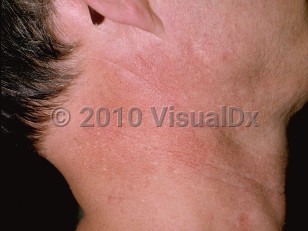Poikiloderma of Civatte
Alerts and Notices
Important News & Links
Synopsis

Poikiloderma of Civatte is a chronic, benign skin condition caused by long-term sun exposure in adults with lighter skin phototypes. It affects women more frequently than men and typically appears in and after the fifth decade of life. It presents as mottled erythema involving the lateral neck and the superior medial chest. Telangiectasias, hyper- and/or hypopigmentation, and superficial (epidermal or superficial dermal) atrophy may also be seen.
Poikiloderma of Civatte develops slowly over months to years. As many as half of all patients may complain of mild itching, burning, or flushing in affected areas. Contact sensitization to chemicals present in fragrances and cosmetics has been proposed as a cofactor in the development of this disorder.
Poikiloderma of Civatte develops slowly over months to years. As many as half of all patients may complain of mild itching, burning, or flushing in affected areas. Contact sensitization to chemicals present in fragrances and cosmetics has been proposed as a cofactor in the development of this disorder.
Codes
ICD10CM:
L57.3 – Poikiloderma of Civatte
SNOMEDCT:
45265000 – Poikiloderma of Civatte
L57.3 – Poikiloderma of Civatte
SNOMEDCT:
45265000 – Poikiloderma of Civatte
Look For
Subscription Required
Diagnostic Pearls
Subscription Required
Differential Diagnosis & Pitfalls

To perform a comparison, select diagnoses from the classic differential
Subscription Required
Best Tests
Subscription Required
Management Pearls
Subscription Required
Therapy
Subscription Required
References
Subscription Required
Last Reviewed:10/27/2020
Last Updated:11/02/2020
Last Updated:11/02/2020
 Patient Information for Poikiloderma of Civatte
Patient Information for Poikiloderma of Civatte
Premium Feature
VisualDx Patient Handouts
Available in the Elite package
- Improve treatment compliance
- Reduce after-hours questions
- Increase patient engagement and satisfaction
- Written in clear, easy-to-understand language. No confusing jargon.
- Available in English and Spanish
- Print out or email directly to your patient
Upgrade Today


